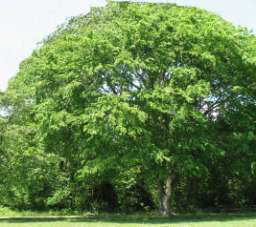 American Elm
American Elm
(Ulmus americana)
|
Classification |
|
Kingdom: | Plantae
|
|
Division: | Magnoliophyta |
|
Class: | Magnoliopsida |
|
Order: | Urticales |
|
Family: | Ulmaceae |
|
Genus: | Ulmus |
|
Species: | U. americana |
Characteristics: The American Elm is a deciduous tree, sometimes growing to more than 100 feet tall with a trunk 4 feet or more in diameter. The crown forms a high, spreading canopy. The leaves are alternate, 2.5 to 4 inches long, with sharply serrate edges, and an oblique base. The flowers are small, purple-brown, and have no petals because they are wind pollinated; the flowers emerge in early spring before the leaves. The tree is capable of self-pollination because the flowers each have both male and female parts.
 The fruit is a flat samara 0.8 inches long and 0.5 inches wide, with a circular wing surrounding the single 0.15 inch seed. The American Elm reaches reproductive maturity at around 15 years of age. Today, it is uncommon for the tree to reach over 10 years of age because of its susceptibility to Dutch elm disease. However, disease resistant trees have been developed.
The fruit is a flat samara 0.8 inches long and 0.5 inches wide, with a circular wing surrounding the single 0.15 inch seed. The American Elm reaches reproductive maturity at around 15 years of age. Today, it is uncommon for the tree to reach over 10 years of age because of its susceptibility to Dutch elm disease. However, disease resistant trees have been developed.
Habitat: American Elm grows well in moist soils, especially valleys and flood plains, and mixed hard wood forests.
Range: It can be found from southern Canada to central Florida, into central Texas. However, the species has been planted beyond its range as far north as central Alberta and also survive desert heat in Arizona.
Native American Uses: The American Elm was used by the Native Americans to make infusions and teas for treating colds. In addition, the Elm timber was used for building materials and tools. Groups that utilized this species included the Delaware and the Chippewa Indians.
Colonial Uses: In Colonial England, the leaves of some elm species were used to treat bruising and burns. Decoctions made from the roots, leaves, or bark were said to heal broken bones and shrink tumors.
Modern Uses: American Elm is used widely as a shade and street tree, because of its shape and tolerance of stress factors. The wood is also used for containers, furniture, and paneling.